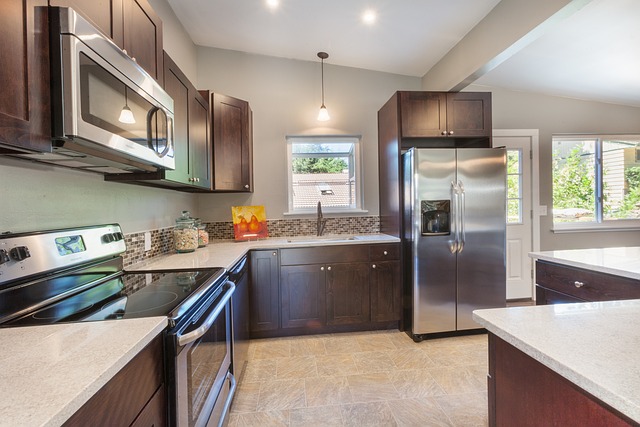Proper kitchen lighting design balances task and ambient illumination using durable materials like granite countertops and stainless steel appliances to enhance brightness, prevent harsh shadows, reduce eye fatigue, and foster a welcoming culinary environment. Integrate under-cabinet lights, LED strips, recessed lighting, and dimmable wall sconces for optimal functionality and ambiance while leveraging the reflectivity of durable kitchen materials for harmonious design.
In today’s modern kitchens, proper lighting is not just functional but essential. Balancing task and ambient lighting creates a comfortable, inviting space. This article explores how to integrate these fixtures seamlessly. We’ll delve into the role of each type of lighting, offering tips on choosing durable kitchen materials for fixtures that stand the test of time. Learn strategies for optimizing light levels, ensuring your kitchen is both well-lit and aesthetically pleasing.
Understanding the Role of Task and Ambient Lighting
Proper lighting design goes beyond aesthetics; it’s a functional necessity, especially in spaces like kitchens where tasks demand varied levels of illumination. Task lighting, as the name suggests, is focused and direct, targeting specific areas for precise work, such as preparing meals or using a kitchen island. These lights, often adjustable, ensure clarity and reduce eye strain by providing bright, targeted illumination.
Ambient lighting, on the other hand, creates a general glow that fills the entire space, setting the mood and defining the overall atmosphere. In a kitchen, this could be soft overhead lighting or recessed fixtures strategically placed to illuminate walls and cabinetry. Balancing task and ambient lighting is key; durable kitchen materials like granite countertops and stainless steel appliances reflect light, enhancing brightness without harsh shadows. This combination ensures functional efficiency, prevents eye fatigue, and contributes to a welcoming and well-lit culinary environment.
Choosing Durable Kitchen Materials for Lighting Fixtures
When it comes to choosing lighting fixtures for your kitchen, selecting durable materials is a top priority. Kitchen environments can be demanding, with frequent use and potential exposure to moisture and heat. Opting for fixtures crafted from robust materials ensures longevity and reduces the need for frequent replacements. Materials like stainless steel, brass, and glass are excellent choices due to their resistance to corrosion and ability to withstand high temperatures.
Stainless steel, in particular, is a popular pick as it not only adds a sleek, modern aesthetic but also offers superior durability. It resists fingerprints and stains, making it a practical option for busy kitchens. Brass fixtures provide a warm, classic look and are highly durable, while glass can enhance lighting effects and come in various styles, from frosted to clear, catering to different design preferences.
Integrating Task Lighting in Your Kitchen Layout
In a well-lit kitchen, tasks become more manageable and enjoyable. Integrating task lighting into your kitchen layout is essential for creating a functional and inviting space. Overhead lights are common but often leave areas like countertops and work surfaces inadequately illuminated. Consider under-cabinet or led strip lights to provide focused, direct light where it’s needed most—over cutting boards, stove tops, and sinks. These durable kitchen materials can withstand frequent use and cleaning, ensuring your task lighting remains reliable and easy to maintain.
By combining task lighting with ambient fixtures, you can achieve a balanced illumination that caters to various needs. Ambient lighting, such as ceiling fixtures or wall sconces, sets the overall mood and provides general brightness. When combined with targeted task lighting, it creates a flexible environment that supports everything from preparing meals to entertaining guests. This thoughtful approach ensures your kitchen is not only well-lit but also designed with durability in mind, fitting seamlessly into the heart of your home.
Strategies for Incorporating Ambient Lighting to Enhance Space
Incorporating ambient lighting is a strategic move to transform any space, including kitchens, into a functional and inviting area. This type of lighting sets the overall mood and atmosphere, complementing task lighting that focuses on specific tasks like cooking or food preparation. For kitchens, especially those with durable kitchen materials, ambient lighting can be subtly integrated through various strategies. One approach is to install recessed lights or LED strips beneath cabinets or along countertops. This creates a soft glow that illuminates the entire room without overwhelming work areas with direct light.
Additionally, incorporating dimmable wall sconces or floor lamps at strategic points across the kitchen allows for adjustable ambient lighting. This flexibility enables homeowners to set the desired ambiance, from a warm and cozy atmosphere during intimate gatherings to a brighter, more energetic space for everyday meals and activities. The key is to strike a balance between task illumination and ambient warmth, ensuring that every corner of the kitchen feels both functional and inviting.
Balancing Light Levels: Tips for Optimal Kitchen Illumination
In a well-lit kitchen, both task and ambient lighting play crucial roles in creating a functional and inviting space. Balancing light levels involves understanding how different types of fixtures can enhance various areas of the kitchen, especially when considering durable kitchen materials that require clear visibility for tasks like food preparation and cooking.
To achieve optimal illumination, start by installing task lights near work surfaces and overhead cabinets to provide direct, focused lighting for specific tasks. Complement these with ambient fixtures strategically placed to fill in shadows cast by task lights and create a warm, inviting atmosphere. When selecting durable kitchen materials like granite countertops or stainless steel appliances, ensure that the overall lighting design accounts for their reflectivity and how they can interact with different light sources.
Proper lighting is essential for a functional and inviting kitchen. By combining task and ambient fixtures, you can create a well-lit space that caters to various activities while adding aesthetic appeal. When selecting lighting solutions, consider durable kitchen materials to ensure longevity and maintain a consistent design. Integrating these strategies allows you to achieve optimal illumination, enhancing both the practicality and visual allure of your culinary hub.
